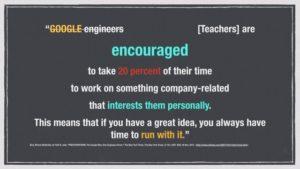Ten (10) critical items to assess a teacher’s effectiveness
I was once told “Anyone can teach.” I believe this is partly true but being an effective teacher requires time, effort, and preparation. Attempting to teach a lesson without certain critical items in place can be done but the question is should it. I say no. If you have chosen to share your knowledge with your students then you choose to invest in their learning.
Here are the ten critical items to assess a teacher’s effectiveness:
1) Clearly Defined Goals
Teachers must have well-defined goals, before starting the lesson. The goals need to include more than academic success; behavioral, social awareness, and development need to follow in lockstep with the academic achievements. These goals need to include a vision that all the students will succeed. Teachers should communicate the goals clearly to the students and all goals should be measurable.
2) Communication & Confidentiality
Teachers need to establish a clear line of communication with their students. They need to state that any communication or interaction with the students is a confidential activity and can only be disclosed if required by law or current regulations. The teacher defines the boundaries of such communication, differentiating his/her role from the role of a counselor or school nurse. Sometimes this can be a silent communication if the teacher feels that the student has issues not directly related to their learning ability but possibly related to family or social problems.
3) Use of Time & Pacing
Lesson should include time management and partitioning of activities, in order to be tracked effectively. Teachers need to emphasize the importance of keeping each activity within the time allotted. The transition from each activity needs to be smooth and not an abrupt termination of the previous. This will avoid spending idle time on any topic or overrunning into the next topic.
4) Use of Resources/Material Management
As a part of the lesson plan, teachers need to ensure availability of any resources or material needed to complete the lesson, in order to avoiding wasting time looking for them in the middle of the class. If the resources/materials are not available, modification of the plan might be necessary, but advance planning can eliminate or minimize that issue.
5) Strategic Questioning
The lesson plan needs to include questions connecting to the learning objective. It is important that the questions assess the students’ understanding of the current subject/topic. The questions should activate critical thinking and force an answer beyond a dry yes or no.
6) Student Movement
The teacher needs to monitor and limit student movement to a minimum. At the same time, controlled movement to assemble students in teams for group activities is desirable. Encouraging the students to stand-up or step-up to the front is, also, a necessary action, when students need to focus on a specific activity or to increase their comfort level in public speaking.
7) Differentiation
The lesson plan design aims to meet the learning requirements for the whole class. At the same time, it is important to include some flexibility to accommodate changes that might be necessary for individual students with special needs. Plans need to accommodate a slower pace if a small number of students have difficulty following the plan, so they have the opportunity to maintain the same level of understanding as the rest of class.
8) Student Engagement & Participation
Teachers need to engage the students to participate in all activities. Sometimes the participation focus needs to be with students that are nervous or reluctant to participate or have a lack of confidence. At the same time, it is important to avoid giving the forum to the same students continuously, in order to avoid domination of the forum by a few. This will require a very tactful approach to avoid alienating the frequently participating students.
9) Monitoring & Checking for Understanding
During the engagement and participation process, it is important to monitor and question the students in order to ensure the level of understanding, before moving to the next topic. Any questions to check the level of understanding need to be presented in a way that prepares the students that this will be a regular activity and encourage them to ask questions during the lesson, instead of only expecting the learners to answer the questions at the end.
10) Classroom Management
All the items listed above are directly or indirectly associated to classroom management. At the same time, this management requires a complicated combination of activities. Teachers should not view these activities in isolation, as they cannot be documented individually. Management is a dynamic activity influenced by many variables. Even if someone observed the same teacher in a lesson with the same students, more than once, it is likely that the dynamics will require the teacher to act differently, in order to maintain the same level of management. The teacher’s best asset can be the ability to successfully modify the class and adapt it to the dynamics of the moment.


